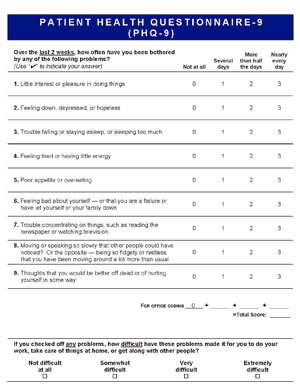Depression
Common Types & Signs (From National Institute of Mental Health)
- Major Depression: severe symptoms that interfere with your ability to work, sleep, study, eat, and enjoy life. An episode can occur only once in a person’s lifetime, but more often, a person has several episodes.
- Persistent depressive disorder—depressed mood that lasts for at least 2 years. A person diagnosed with persistent depressive disorder may have episodes of major depression along with periods of less severe symptoms, but symptoms must last for 2 years.
- Postpartum depression, which is much more serious than the “baby blues” that many women experience after giving birth, when hormonal and physical changes and the new responsibility of caring for a newborn can be overwhelming. It is estimated that 10 to 15 percent of women experience postpartum depression after giving birth.
- Seasonal affective disorder (SAD), which is characterized by the onset of depression during the winter months, when there is less natural sunlight. The depression generally lifts during spring and summer. SAD may be effectively treated with light therapy, but nearly half of those with SAD do not get better with light therapy alone. Antidepressant medication and psychotherapy can reduce SAD symptoms, either alone or in combination with light therapy.
- Bipolar is cycling of mania and depression (highs lows, used to be “manic depressive disorder”
How depression is covered up
- Seclusion: Common in new moms
- Video Games: The Washington Postrecently reported that there are more adult woman gamers than teen boy players in the world. “Internet Gaming Disorder” even made its way into the DSM-5, the diagnosis guidebook for psychiatrists and other helping professionals. Video game addiction has the potential to grow into one of the most challenging addictions to treat.
- TV, alcohol, and sleep issues
“Normal” teen behavior vs. Depression
- Teens are moving toward independence
- Hormones are going crazy, the pleasure center of the brain is magnified while the frontal lobe (decision-making) is muted. It’s any wonder we survived the teen years
- Normal teens are: moody, challenging, affectionate one day and a jerk the next.
- KNOW YOUR TEEN’S BASELINE
Red Flags and when to get help
TWO QUESTIONS: Answer PHQ-2
“not at all = 0”
“Several Days = 1”
“More than half the days = 2”
“Nearly Daily = 3”
- Past two weeks have you had little interest or pleasure in doing things?
- Feeling down, depressed, or hopeless
Did you score above 3? Take the PHQ-9 assessment below
Depression Patient Health Questionnaire 9
Down load the PHQ-9 Depression Assessment
Have questions? Want to start counseling?
[CONTACT-US-FORM]



